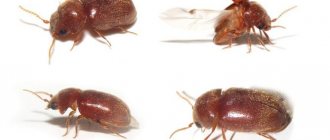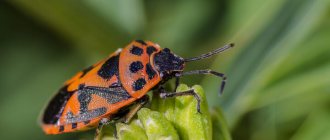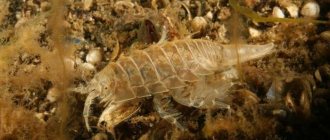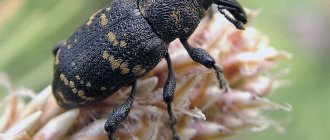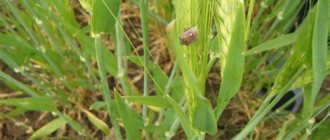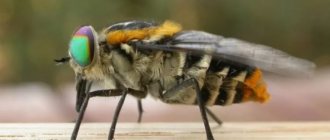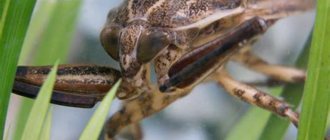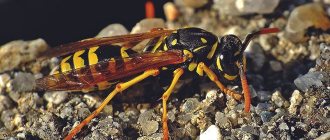Description of the woodworm
The butterfly of this species reaches impressive sizes: the wingspan of the female is 100 mm, the male is 70 mm. The color on different parts of the body varies:
- The forewings can be all shades of gray (sometimes with a brown tint) with a fuzzy gray-white marbled pattern, or dark wavy lines located across the wing.
- The hind wings have a rich dark brown tint, over which there are matte lines several shades darker.
- The chest is brown closer to the head, with a velvety black stripe running across it. Near the abdomen the shade becomes paler.
- The abdomen is dark gray, with clearly visible light gray scales.
In adult females, the retractable ovipositor is clearly visible, they are larger and thicker. The body and wingspan of the male are much smaller. Both individuals have a short, underdeveloped proboscis. The entire body of the woodworm butterfly is covered with short hairs.
The eggs of this pest have an elongated shape, reaching up to 1.5 mm in length. Their color is light brown with dark gray stripes. After hatching, the larvae (or caterpillars) reach impressive sizes - up to 80 mm in length and up to 12 mm in thickness. Their body is deep red in color, later it changes color to yellowish-red. The head and dorsal scutes are black. The caterpillars have a powerful jaw that can bite through human skin.
The peculiarity of this species is the pungent smell of wood vinegar, noticeable at a distance of several meters.
Dark brown pupae of the woodworm are found in cocoons made from wood pieces. Their size reaches 30 mm.
Appearance at different stages of development
The insect belongs to the order Lepidoptera or butterflies.
The adult is nocturnal. The front wings imitate the pattern of tree bark, which allows the butterfly to remain invisible. The hind wings are somewhat darker and transversely striated. The insect's chest has a characteristic pattern. The appearance of the mask is given by the gradation of color - dark at the top, it becomes lighter closer to the abdomen. A black horizontal stripe divides the chest into two uneven parts. A rare feature of moths is the absence of a mouthparts. The fragrant woodborer does not feed, but lives off the reserves that it accumulates in the caterpillar stage.
Like all nocturnal moths, the willow woodborer has well-developed olfactory organs. Sensillae are localized on the surface of the antennae.
The hearing organs are located at the base of the abdomen or in the metathorax. The odoriferous woodborer perceives high-frequency sounds and ultrasound, which allows it to respond to the approach of bats.
Woodworm
The butterfly's abdomen is oblong, thick, with well-defined segments. Dense gray pubescence is visible along the outer edge of the segments. Hair-like scales cover the entire body of the imago, except for the complex compound eyes.
The size of an adult female is slightly larger than the male. The sex of the butterfly can be distinguished not only by size, but also due to the clearly visible ovipositor extending from the abdomen.
A large, heavy butterfly flies low above the ground. In the evening and at night, she crawls along a tree trunk. By folding its front wings into a tent, the insect protects its abdomen with them, which makes it indistinguishable against the background of folds of the bark.
The caterpillar is large and bright. The color of the chitinous cover changes with age. Juveniles are pink. Gradually, the caterpillar darkens, acquiring a reddish-brown or cherry color with a darker back. The body is covered with sparse hairs. The head is black, equipped with powerful mandibles - jaws, at the base of which there are glands that secrete a secretion with a strong odor of wood vinegar.
The pupa is reddish-brown with a light yellowish abdomen.
Range and habitats
The habitat of the woodworm is considered to be Europe (Eastern and Western), the Caucasus Mountains and Western Siberia. Occasionally, the insect can be found in North Africa and Asia Minor.
The main habitat is mixed and deciduous forests, trees located in floodplains, gardens and parks in cities. The Caucasus Mountains are inhabited by this insect right up to the upper border of the forests. In zones with a hot and arid climate, the wood borer lives in lakes or floodplains and is predominantly nocturnal.
Caterpillar of a woodworm butterfly, similar to a beetle larva
If you are asked: “What insect lives under the bark of trees, gnawing holes there?”, you will probably think of the larva of some beetle, for example, a bark beetle. What if I told you that a caterpillar from which a butterfly hatches could have this lifestyle? There is a whole family of large moths - woodborers (lat. Cossidae), which gnaw passages in wood with powerful jaws, leaving passages filled with small sawdust, gnawing out the tree from the inside. The butterfly captured in the photo also belongs to this family. This is most likely an odorous wood borer , also known as a willow wood borer , or a wood borer (lat. Cossus cossus). Externally, the caterpillar most likely resembles a beetle larva: a large naked fleshy body of pale cherry color with a dark back, divided into segments with round spiracle openings on each; flattened black head with powerful serrated jaws. It was nicknamed odorous because, by making passages under the bark of a tree, it damages the vessels of the plant, and sweet juice flows down the tree trunk, to which insects flock, it is fermented by bacteria, which is why a strong smell of wood vinegar appears around. It is called willow after one of its food plants. It’s hard to imagine that such a not-so-pleasant caterpillar will grow into a large and quite beautiful moth.
The odorous wood-borer , or willow wood-borer , or wood-borer (lat. Cossus cossus) is a large nocturnal moth from the wood-borer family. The wingspan is up to 10 cm. The color is brownish-gray with numerous dark wavy transverse lines and light spots. Caterpillars are xylophages, lead a hidden lifestyle, gnaw tunnels in the trunks of woody plants.
The caterpillars are xylophagous and feed on the wood of willow, poplar, aspen and alder. Sometimes they can live in fruit trees: pear, apple, plum, cherry, quince, apricot, walnut, persimmon, European olive, wild olive, mulberry, sea buckthorn. The forage species also include: ash, birch, beech, oak, maple, small-leaved elm, squat elm and others.
Caterpillars of the first instar are pink or cherry-red in color; the last instars are brown-red with a darker back and a black head. At the end of their development they reach a length of 80-120 mm. The caterpillars overwinter in a chamber gnawed out of wood at the end of the passage inside the trunk, closed with a plug made of drill flour. (Drill flour is small sawdust that is produced by various insects that live inside the wood of various trees and make passages in it with the help of their upper jaws. Drill flour is found in the passages that were made by insects, and can also protrude out of the so-called flight paths holes. Some of this flour lies in heaps in front of the outlet holes, some crumbles off.)
Caterpillars of the first instar stay in groups, gnawing under the bark and forming an extended common passage on the surface of the phloem. Later, young caterpillars damage the bast layer and cambium, where they make numerous interconnected passages filled with drill flour and excrement. After the first winter, each caterpillar makes a separate move deep into the wood and to the root of the trunk, where it continues to develop. The passage of an adult caterpillar is a large, wide-oval hole with a diameter of 12-16 mm.
On old trees with thick bark in the lower part of the trunk, the caterpillars eat out individual long passages only after the first winter. On thinner trunks with smooth bark, the caterpillars penetrate the wood earlier, usually within a month of hatching.
The caterpillars usually inhabit old and diseased trees, but can also be found in young and healthy trees. Affected trees are easily detected by the red-brown feces thrown out by the caterpillars, to remove which from their passages the caterpillars gnaw special holes in the bark. Sap usually flows along the bark of trees inhabited by caterpillars, to which various insects often fly, and the affected trees emit a rather strong odor of wood vinegar.
Before pupation, usually at the end of summer - autumn, the caterpillar leaves the tree trunk, burrows into the soil near it, where it builds a dense silk cocoon, weaving soil particles into its walls. Pupation in early spring. The pupal stage is from 2 to 6 weeks. In the northern regions of the European part of the country and in Siberia, the caterpillars do not leave the tree trunk in the fall, but gnaw out the chamber at the end of their stroke. In it, a kind of cocoon is built from drill flour, in which they winter again. In spring, adult caterpillars continue to feed until June. They then leave the trunk and pupate in the soil.
Large size butterfly. The wingspan of males is 65-70 mm, females - 75-100 mm. The venation of the wings is primitive. The butterfly's forewings are gray-brown to dark gray with a marbled pattern and unclear, blurry gray-white spots, as well as dark transverse wavy lines. The hind wings are dark brown with matte dark wavy lines. The chest is dark, brownish-gray on top, with a velvety black transverse stripe, whitish towards the belly. The abdomen is thick, dark gray, with dense pale gray hair-like scales along the posterior edge of each segment. The abdomen of the female has a retractable, clearly visible ovipositor. The proboscis is short - the oral apparatus is underdeveloped. The male is slightly smaller than the female.
The range includes Eastern and Western Europe, the Caucasus, Western Siberia, North Africa, Asia Minor and Western Asia. It is found throughout the zone of mixed and deciduous forests, in floodplain forests, shelter belts, gardens and parks. In the Caucasus and Transcaucasia they are found up to the upper limit of the forest, in Turkmenistan and Tajikistan in oases and tugai forests along river banks, less often in mountain forests. The species is sedentary and nocturnal. The flight of butterflies in the central European part is from late May to early August.
And this is what the fragrant wood moth butterfly looks like (photo from Wikipedia):
SIP Haapala / wikipedia
The fragrant woodborer is listed in the Red Book of the Republic of Tatarstan.
Life cycle
The life of this insect consists of four stages: egg, caterpillar, pupa and butterfly.
Egg
Adults lay eggs in late June-early July. They are placed in crevices and cracks in the bark of trees. Eggs are laid in several batches; the female fills each batch with a quickly hardening liquid. During its life, a butterfly can lay up to 1000-1300 eggs. This stage of the cycle lasts 10-12 days.
Caterpillar
Young hatched caterpillars live together, this is necessary for obtaining food and jointly cutting passages under the bark of trees.
The caterpillar burrows are filled with red-brown excrement. It is through them that the pest can be detected.
Caterpillars overwinter twice during their lives. For the first time - under the bark, with the onset of spring they awaken and begin to actively gnaw independent passages towards the center of the trunk. After the second winter, some of the caterpillars leave the tree and crawl across the surface of the ground in search of a place to pupate.
Doll
Pupation occurs at the end of May, in the second year of the caterpillar's life. The cocoon consists of pieces of bark, soil and silk threads produced by the larva. Its location is soil, stumps or tree bases. The pupation phase lasts for one month.
Butterfly
The life period of butterflies is July-August. They are especially active in the evening, after sunset. Females lay eggs in crevices of bark and wood and fill them with a sticky, quickly hardening substance. They do not require food to procreate. The number of eggs laid can range from 250 to 1300 pieces, on average, each butterfly lays about 1000 pieces.
Reproduction of odorous woodworms
The females of these butterflies lay their eggs, as a rule, in the crevices of trees. There can be 700-1000 eggs in a clutch. She lays them in groups of 15-230 pieces. The eggs are oblong, about 1.2-1.7 millimeters long, light brown in color. They are coated with a sticky substance that hardens when exposed to air.
Willow borer caterpillars eat wood. Caterpillars of the first instar are cherry-red or pink in color, while caterpillars of subsequent instars are darker. At the end of development, the size of the caterpillars is 80-120 millimeters. They spend the winter in passages made in wood. They close the entrance to the chamber using drill flour.
The voracious caterpillars of the woodworm eat all the wood that comes in their way.
Caterpillars of the first instar create a common course and stick together. The passages are filled with caterpillar excrement and drill flour. After wintering, each individual gnaws deep into a separate passage, where they develop.
An adult caterpillar makes passages with a peg diameter of 16 millimeters. On trees with thick bark, caterpillars make their burrows only after the first winter, but on trees with smooth, thin bark, they penetrate the wood earlier, most often a month after hatching.
The color of the woodworm serves as an excellent camouflage. It is indistinguishable from wood.
At the end of summer, the caterpillar leaves the tree and burrows into the soil next to the tree. She then makes a silk cocoon by adding bits of soil to its walls. The caterpillar pupates in that cocoon.
In the northern part of the range, the caterpillars do not emerge from the wood, but make a chamber at the end of their course. In this chamber, the caterpillar constructs a kind of cocoon from drill flour. She spends another winter in it. In spring, adult caterpillars remain in the tree, and in June they emerge from the trunk and turn into pupae in the soil.
A woodworm butterfly emerging from a pupa
What does it eat?
The basis of the diet of the odorous woodworm is made up of deciduous species growing both in the garden and in the forest:
- willow;
- poplar;
- oak;
- alder;
- aspen;
- Walnut;
- Apple tree;
- pear;
- Rowan;
- Linden;
- white acacia.
The caterpillars feed on the bark and the wood itself, making passages and burrows in the trunk.
Most often, the pest damages species with soft wood or trees growing singly, as well as weakened and diseased plants.
Appearance of the willow woodborer
Males have a wingspan of about 70 millimeters, while females are larger - their wingspan is 75-100 millimeters.
Wood borer (Cossus cossus).
The forewings of the woodworm can be gray or grey-brown with off-white spots and dark transverse lines, creating a marbled pattern.
The hind wings of the woodworm are fragrant dark brown with dark matte lines.
The chest is dark in the upper part, and towards the abdomen it becomes lighter and becomes almost white. The abdomen is thick, dark gray in color. It is covered with hair-like scales. Females have a retractable, clearly visible ovipositor.
Damage caused by woodworm
The main damage to trees is caused by caterpillars. Immediately after hatching from the eggs, they reach the young shoots and penetrate inside, to the core. As it grows, the pest's passages increase in length, first horizontally, damaging blood vessels and weakening the tree, then downward to the base of the trunk.
A tree affected by woodworm loses its attractiveness: shoots die en masse, leaves in the crown dry out and fall off. Yields of fruit crops are sharply reduced. The tree becomes weakened and cannot resist fungal and bacterial diseases. In the absence of measures aimed at exterminating the pest, it completely dries out and dies.
What methods of woodworm control do you use?
Folk
Chemical
How to deal with a pest
You can fight scale insects on grapes using various methods.
Simple ways
The wax armor worn by the scale insect is an excellent protection for the insect. It prevents chemicals from penetrating the insect’s body, which makes the fight against scale insects on grapes very difficult. Therefore, if the number of insects is small, you can use a brush with metal bristles.
You can protect your vineyard from scale insects by attracting predatory insects, examples of which are wasps or ladybugs. It is enough to simply release them into an infected vineyard.
Chemical exposure
A more effective way to combat scale insects is to use chemical repellents:
- Aktara is the most popular contact-intestinal insecticide with a wide spectrum of action. The product is available in the form of a concentrated suspension and in the form of granules. The active ingredient is thiamethoxam, a toxic substance that affects insects both when watering (within 24 hours) and when spraying (for 2-4 hours).
- BI 58 new - systemic insecticide is a concentrated emulsion based on dithiophosphoric acid. Affects insects by contact and intestinal means. The emulsion is diluted in accordance with the instructions, and the resulting solution is used for spraying. To achieve maximum results, twice the application is required. The protective effect lasts for three weeks.
- Confidor Extra is a systemic insecticide effective against sucking and gnawing pests. The active substance in the granular product is imidacloprid, a toxic substance that affects insects upon contact, as well as with food. The residual effect lasts for a month.
Folk recipes
Despite the fact that folk remedies are less effective than chemical drugs, they are also safer. To combat scale insects on trees in the garden, including grapes, currants, lemons and conifers, you can use simple methods.
Garlic and soap
To prepare a working solution for treating grapes against scale insects, mix grated laundry soap with chopped garlic. Then the resulting mixture is combined with water in a ratio of 1:3. The resulting solution is filtered and used to spray grapes infected with scale insects. A day after the procedure, the product is washed off with a water jet. Such treatments should be carried out every 3 days until the pests completely disappear.
It is good to use onion infusion to protect grapes from scale insects. To prepare it, 4 finely chopped onions are poured into 1 liter of water, and then left to infuse for 4 hours. The strained infusion is used to spray grapevines.
One of the popular folk remedies is wood ash. To combat scale insects, use an infusion based on it. 300 g of the substance is poured into a liter of boiling water and left for 30 minutes. Then filter and dilute with 9 liters of water. The solution is used to spray grape bushes affected by the pest.
Hot pepper
An infusion of hot pepper has an equally effective effect. 100 g of crushed fruits are boiled in 1 liter of water for 15 minutes. Leave for 24 hours, after which the concentrate is filtered and used to prepare a working solution: 1 liter of water is mixed with 10 g of pepper concentrate and 5 g of green soap.
Celandine
A recipe made from celandine will not require much expense. 3 kg of fresh herbs are infused in a bucket of water for 24 hours. The strained infusion is used to treat grape leaves damaged by scale insects.
Fern
Fern also has repellent properties. A decoction is prepared from it, which is used to spray the grapevine. 1 kg of fresh plant is infused in 10 liters of water for 24 hours, then boiled for 30 minutes. The cooled and strained decoction is used to treat infected vines.
Signs of colonization of an area by woodworm
The population of this pest can be identified by the following signs:
- sap found at the bottom of the trunk;
- the sharp and persistent smell of wood vinegar, which is felt next to the tree trunk;
- wide passages, oval in shape on branches and bark;
- drill flour on the surface of the bark. It looks like small sawdust of brown or yellow color;
- changes in the appearance of the tree: dried branches, bark falling away from the trunk, falling leaves.
In some cases, the pest can be detected by caterpillars migrating along the ground to the place for pupation.
Grape pest control: photos, how to treat plants
In central Russia there are practically no insects that cause significant damage to grapes in open ground. The most dangerous pests, common in the industrial viticulture zone, are not able to tolerate cold northern winters.
Spider mites can be considered the main pests of grapes in the Non-Black Earth Region. They appear infrequently, but in some dry years their numbers increase greatly. Feeding on leaves and young shoots, mites pierce the integumentary tissue and suck out the juice. Affected leaves are stunted in growth, and with severe infection they become slightly silvery, dry out and fall off.
Female ticks overwinter in plant debris, in the top layer of soil, and in crevices of garden buildings. Currently, there are various preparations for protecting grapes from pests that effectively destroy insects. If sulfur-based anti-oidium preparations are used, then the number of mites will decrease. If there is a strong spread in the previous season, the first treatment to control grape pests is carried out during the swelling of the eyes, the second - after flowering, in the second half of June, the third and subsequent treatments - in case of a large number of the pest.
Grape pests - snail in the photo
Another grape pest is a variety of snails. There are especially many of them in years with a lot of precipitation. With the warming of the climate in the Non-Black Earth Region, the largest of them appeared - grapes, the diameter of which is 5 cm.
Females lay eggs in heaps in the ground; the hatching larvae are similar to adult snails, only much smaller. They live in damp places, in weeds, and in dense plantings. They feed on leaves, green shoots, and fruits. Two generations of the pest develop in a year.
Before treating grapes against these pests, you need to collect snails. It is also necessary to remove weeds and thin out dense plantings.
On planting material purchased from trusted places and following agricultural practices, the appearance of other pests and their causing significant harm is unlikely. If you already know how to spray grapes against pests, do not forget that all work related to the use of chemicals must be carried out in the morning or evening hours, using personal protective equipment and strictly observing the concentration and consumption of the working solution, as well as the multiplicity processing and waiting period specified in the instructions.
These photos show grape pests and remedies for treating the vine:
Control measures and prevention
Mechanical, chemical and biological control measures are used to exterminate the woodworm.
Mechanical methods
This method involves clearing dead bark from trees and collecting the larvae by hand. When working, do not use metal or plastic tools, as they can easily damage the wood. Hands must be protected with rubber gloves. On trees, wounds and areas without bark should be covered with garden varnish.
All collected larvae and damaged bark should be burned immediately after collection.
For timely detection of woodworm, the trunk and crown of garden trees should be inspected at least once a week, throughout the entire period from June to September. If there are damaged young shoots, they should be pruned. Severely affected specimens must be uprooted and burned.
Chemical control measures
Organophosphorus insecticides have shown their effectiveness in the fight against woodworms:
- Actellik.
- Diazinon.
- Karbofos.
- Chlorophos.
- Chlorpyrifos.
The method of use is to soak a cotton ball in the insecticide and place it in the path made by the pests. You can also inject the drug into the hole from a syringe.
Biological methods
This method includes attracting birds whose diet includes insects to the site. First of all, these are tits, woodpeckers, magpies and rooks. You can increase the number of birds by hanging feeders, houses and artificial nests in the garden.
Prevention
To prevent the growth of the woodworm population, it is necessary to regularly remove dead bark and growing moss from the trunks. Cover bare areas with one of these compounds:
- Clay and lime mixed in a 2:1 ratio.
- Clay, glue and insecticide. To prepare the paste, mix 1 kg of clay with water to the consistency of sour cream, add 250 g of wood glue and 90 g of 10% karbofos.
When processing young plants with unsuberized bark, adding glue to the composition is not recommended.
Treatment with the paste should be carried out twice a year: in the spring - after the snow melts and in the autumn - after the leaves fall. The height of applying the paste is up to the growth points of skeletal branches, at least 2 m in height.
The odoriferous woodborer is a dangerous pest of deciduous trees, widespread in Russia and neighboring countries. The caterpillars of this insect can completely destroy both forest green spaces and fruit trees in the garden.
Control measures
You can and should fight against woodworm in order to save the life of a tree or even an entire garden. Various methods are used for this: mechanical, chemical, biological.
Mechanical methods
Mechanical methods of combating odorous woodworm involve thoroughly cleaning damaged trees from pest-infested bark and collecting as many larvae as possible. This can only be done manually so as not to harm the trunk.
Infested bark
All collected biomaterial must be burned immediately. Damage to the tree is covered with a special compound - garden varnish, which is a mixture of water with slaked lime and clay. Lime and clay are taken in a ratio of 2:1 and diluted with water until the consistency of sour cream. The clay in this composition can be replaced with copper sulfate (for 2 kg of lime you need 200-250 g of sulfate). The effect will be even greater.
In the second half of summer and early autumn, it is necessary to regularly examine the crowns of trees, cut off all diseased branches, and cut down trees in critical condition without regret.
Chemical control measures
The chemical method is based on the use of organophosphorus insecticides (karbofos, chlorophos, etc.): you need to soak cotton swabs with the insecticide and place them in the holes gnawed by the caterpillars. The insecticidal agent can be introduced into the labyrinths made by the pest using a syringe or syringe.
Biological methods
The biological method consists of actively attracting birds whose food is insects (woodpeckers, rooks, magpies, etc.) into gardens and parks. To do this, birdhouses and feeders with a variety of food are hung on trees.

